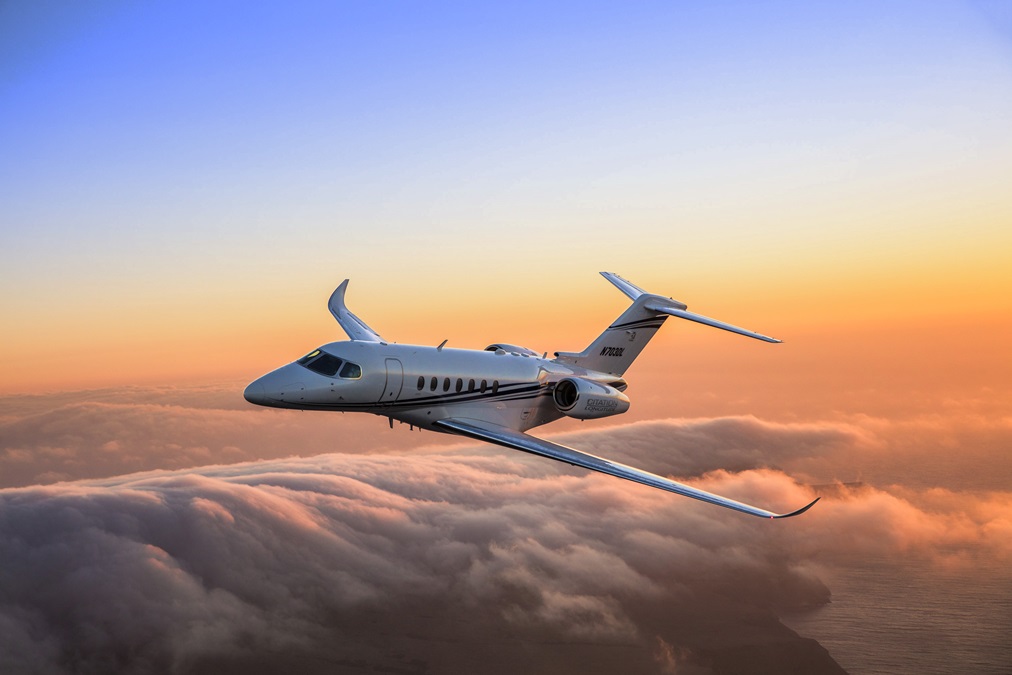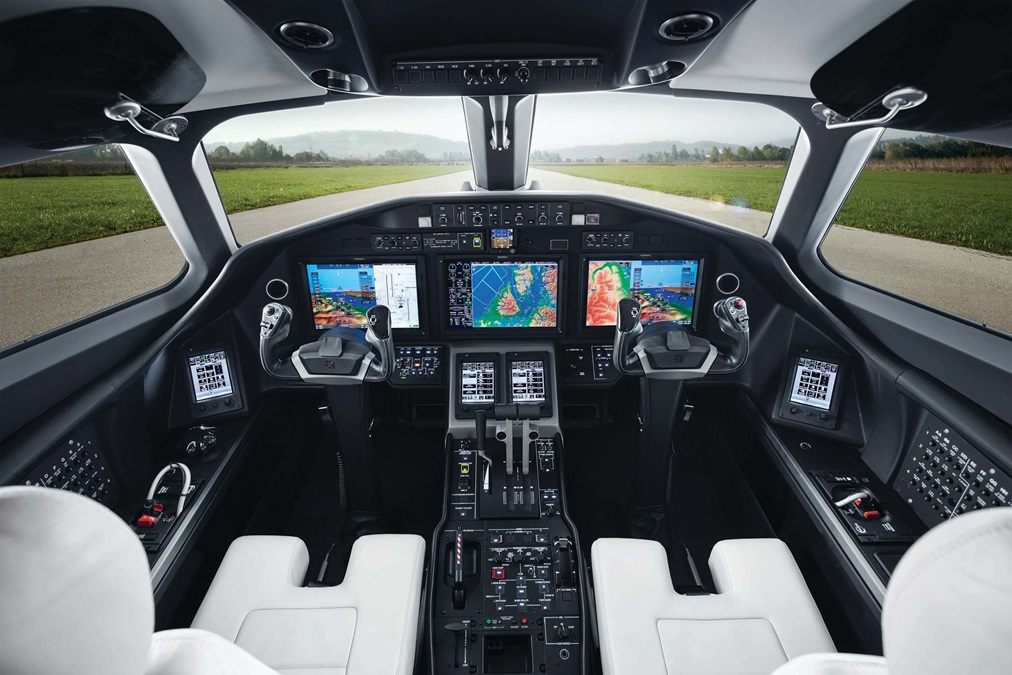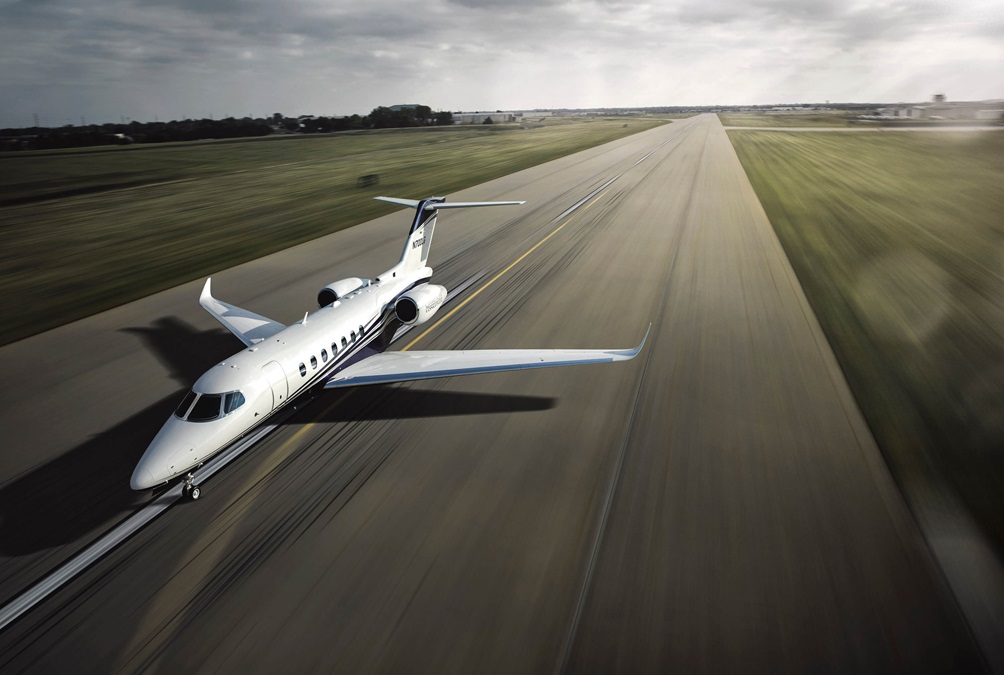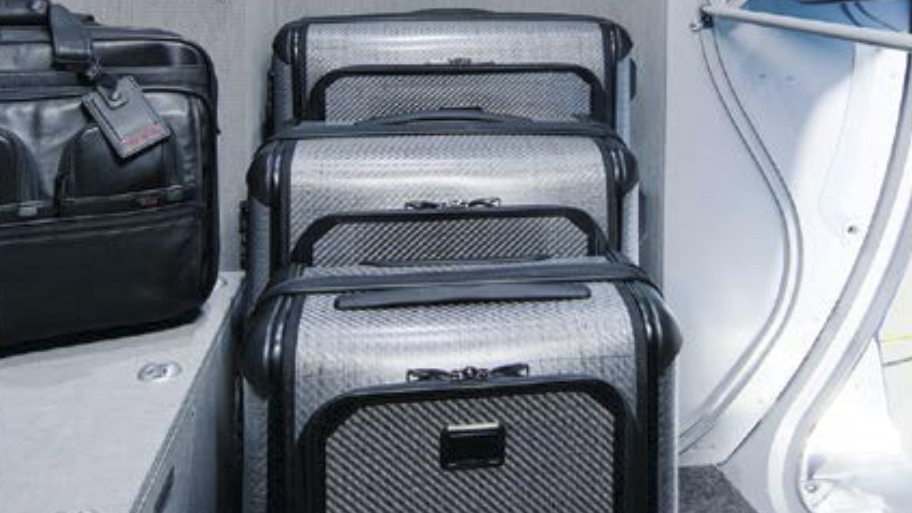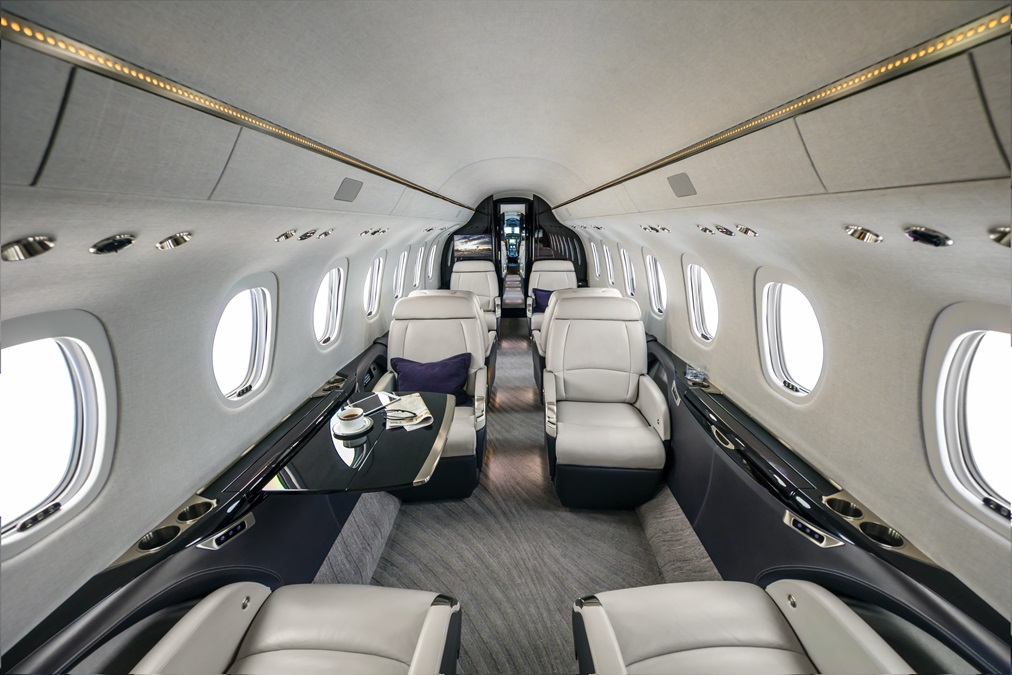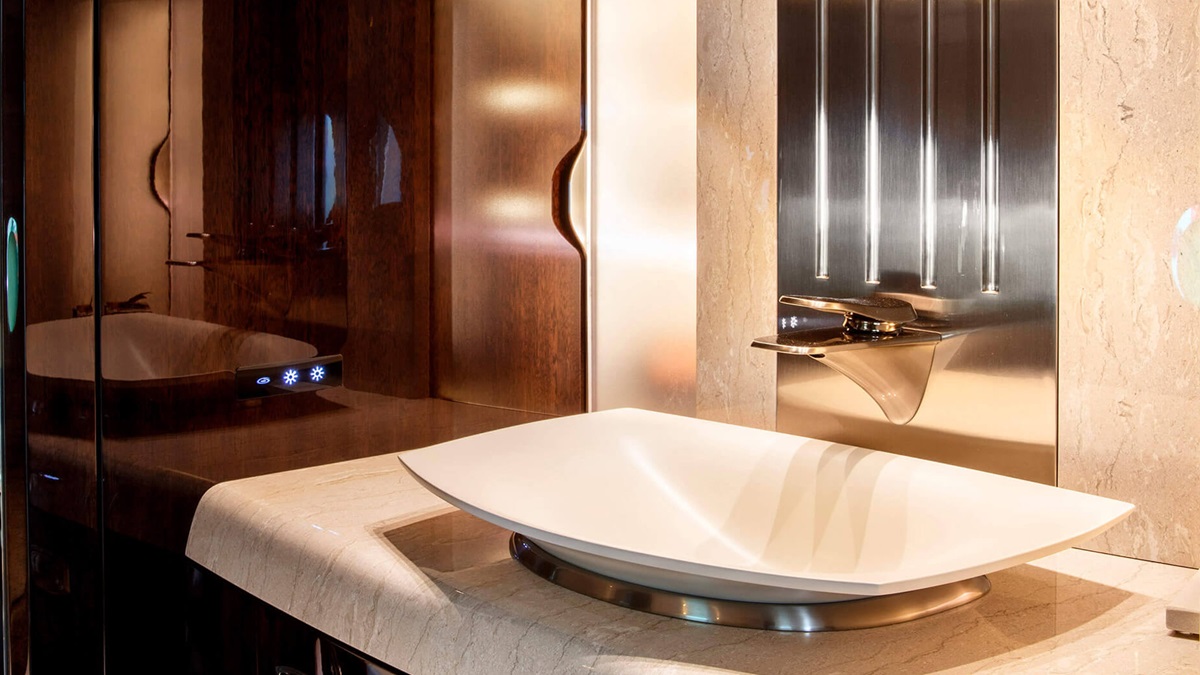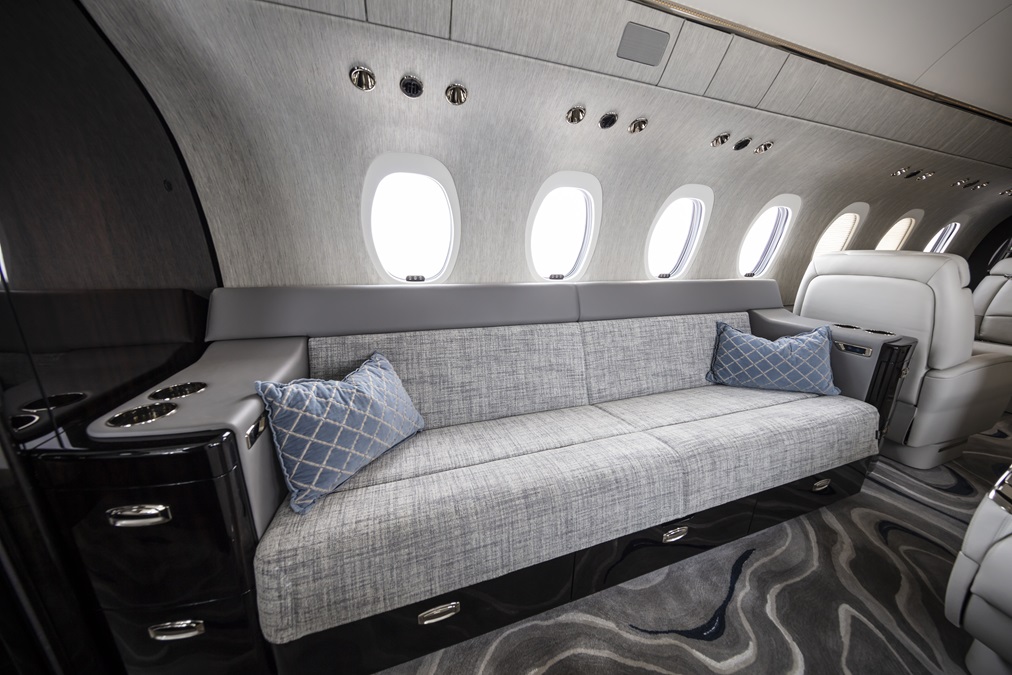Exploring new Longitudes
Textron goes big-cabin with its newest Citation
The Citation Longitude borrows the fuselage tube created for the Latitude and extends it by five feet, providing a six-foot-high cabin, the de rigueur flat floor, and a total of eight seats in a double-club configuration or nine if the optional three-seat divan is chosen. You could call it 10 seats if you include the optional jump seat, which can face forward or aft and can be removed when not needed, freeing up some closet space behind the pilot.
Unlike some jets, the vacuum-powered lavatory is not belted. It is an impressively sized lav nonetheless, through which you can access the baggage compartment in flight—a place to put up to 1,000 pounds of stuff.
From the outside the windows look similar in size to those of earlier Citations, but in fact they are some 30-percent larger and strategically placed so that those in the big comfy seats can see out without hunching over. The divan is berthable. And the forward-facing club seats can be spun 180 degrees. Lay the seatback down and slide the seat end-to-end with the aft-facing seat, also reclined, and you get a flat bed. Unlike some berths, this one is truly flat because as you fully recline the backs, the seat bottom rises. In all, four can sleep flat on the Longitude. Touch the switch on the window frame once and shades deploy. Touch again and blackout shades deploy, creating a dark, comfortable sleeping compartment. That will come in handy as you are hurdled through the air for some 3,500 nautical miles. Textron’s longest trip to date: 3,600 nautical miles, or 7 hours and 30 minutes with an average of 52 knots of tailwind from Columbus, Ohio, to Paris. So, yes, a transatlantic nap would be nice.
If going around and touching all those window shade buttons is too tiring, no worries. There’s an app for that. The app, compatible with Apple and Android devices, controls almost everything in the cabin—shade position, temperature, lighting, entertainment choices and volume, and a variety of other items. You can play music through the sound system from onboard choices or pull it from your favorite device. Same with video to the onboard monitors. There’s also an HDMI cable to direct-connect to the monitors for movies or presentations. And, of course, a plethora of USB connections, cup holders, foldable tables, drawers, and cabinets everywhere for storage. Up front a “refreshment station” is a well-equipped six-foot galley with wet sink and hot water.
With more than 30 inches of knee room between the seats, the Longitude is the roomiest in its class.
But it is the sound level that is most impressive. According to Brad Thress, senior vice president of engineering, the team responsible for acoustics took a technological approach to quieting the cabin, rather than just throwing weight at the problem. Textron created a lab that allows it to detect the amount and frequency of every sound in the cabin—and its source. From there they set out to find ways to quiet each one. For example, they discovered that the velocity of environmental air entering the cabin was so high that it caused quite a ruckus. A few passive zigs and zags in the overhead ducting slowed the air down, reducing noise. “There are hundreds of examples of small things we changed to make a difference,” he said, describing the Longitude as having the “lowest acoustics in its class.” And it is impressive. In flight at cruise, one could easily hear conversations going on in the front section from the back of the cabin.
And to your left
One could describe the cockpit as quiet too—and dark. Other than the shimmering blue “Norm” indications on the square buttons, the cockpit subpanels are dark and not distracting. Above the subpanels, though, the Garmin G5000 integrated cockpit glimmers with loads of information and situational awareness. The three 14-inch displays plus four touch screen controllers allow access to all major systems on the airplane, including synoptics for fuel, electrical, hydraulics, pressurization, anti-icing, and more. While the cockpit looks similar to the Latitude, certified in 2015, the Longitude—expected to be certified by the time you read this—takes advantage of recent developments to include the Garmin NXi-style higher-resolution displays and faster processors. The Longitude includes a great deal more system sensors and more sophisticated systems in general than the Latitude, according to Stuart Rogerson, senior test pilot. The Longitude pilot can tell down to the valve position what is going on with a particular system.
Starting the Longitude is different too. The Latitude’s Pratt & Whitney Canada PW306D1 engines, at 5,900 pounds of thrust each, are about the largest out there that can be battery started. The Honeywell HTF7700L Longitude engines at 7,550 lbst demand an air start, which means a ground cart or the auxiliary power unit, which is how we started N704CL on a 91-degree day in Wichita. With the APU running, I lifted a cover and selected the right Engine Run/Stop button. Verifying a start pressure of more than 32 psi, which happens just about instantly, I pushed the Engine Start button and watched the FADEC do the rest.
Like the start sequence, system tests are mostly automatic. Watching the Crew Alerting System, I could see it running down a long list of checks, including actuating the spoilers, for example. Had I had the flight control synoptics page up, I could have seen a representation of the movement there as well. Good thing, because looking out the four-panel windshield, you can’t see much of the wing, swept at an average of about 28 degrees, and tipped by swooplets—gradually swept winglets. No one used to flying older Citations will miss doing the manual “rotary” tests at the start of the day.
Leaving the prairie
All up and running, I grabbed the tiller wheel on the left side panel and applied a little thrust. Once rolling, the tiller does a steady job of keeping the dual nosegear headed where you want to go, although my less than deft hand had us jerking down the taxiway a couple of times. The brake-by-wire system barely kept us still on the runway as I shoved the levers forward. Once releasing the carbon brakes, we shot down the runway with impressive acceleration, the V1 of 110 knots and VR of 118 knots gone in a flash. I tucked the chevron into the flight director and we dashed upward across the prairie to Flight Level 430. At a maximum takeoff weight of 39,500 pounds, the Longitude can climb to FL430 in about 22 minutes. The climb schedule calls for a step climb to the ceiling of FL450, but Rogerson said during testing they frequently went straight to the ceiling. However, maximum speed of 476 knots is achieved around FL400. At FL430 and a relatively light load with ISA at minus 5, we saw 472 knots or Mach 0.827 while burning 1,700 pounds per hour.
Even at the loftiest altitude, the cabin maxes out at 5,950 feet, giving the bill-payers a comfortable flight at one of the lowest cabin altitudes in the class.
Rogerson extolled the human-factors work Textron did to simplify the cockpit. “We’re trying to build a more intuitive flight deck,” he said. For example, the electrical system displays percentage of amps rather than number of amps being used. “Why make the pilot do a lot of math?” Rogerson asked. Electrical system load shedding is automatic, taking less important systems off line when there’s a power problem, including shutting off electricity to less important windshield panes, for example. Open a door or hatch anywhere on the airplane, and an LED automatically comes on to illuminate that area. Ten minutes later, it shuts off. Thanks to the control-by-wire rudder system, the yaw damper is full time. No need to remember to turn it on after takeoff or off just before landing. Dual hydraulic systems actuate the rudder; a standby electric motor provides triple redundancy. Like other modern Part 25 designs, the flight controls can be split, allowing control even if one or more flight controls becomes inoperative. The fuel system is simple: two wing tanks, each feeding an engine. The crossflow setting pumps to the other tank should an imbalance occur. A single-point refueling system at the right wing root allows the pilot to enter the number of pounds of fuel needed, once again saving the math of converting to gallons.
However, that simple fuel system was causing a bit of a kerfuffle when we visited in September. Late in the certification program, the FAA decided the portion of the tanks inside the wing root fairings constituted a “center fuel tank.” Because of that it must meet the fuel tank flammability requirements demanded by certification changes that occurred after the TWA Flight 800 accident, where the center fuel tank exploded. Textron asked for an exemption, but the FAA said no. Finally, this summer Textron was granted partial exemption through January 2020, allowing the company to complete certification and begin deliveries. However, Textron had to deliver a compliance plan by October 1, 2018. Thress and other executives, tight-lipped about the whole ordeal, said he is confident they would deliver on time.
Although relatively new to swept-wing jets, the Garmin G5000 is remarkably advanced. The autothrottle system is a marvel to watch. Had a pressurization problem occurred and we had passed out, the G5000 would have automatically turned the airplane 90 degrees to exit an airway and would have descended us rapidly to 15,000 feet. A vertical profile presentation across the bottom of the multifunction display shows winds aloft during the descent.
After a descent to 15,000 feet, I cranked the Longitude around for some steep turns and a few stalls to the shaker. We didn’t go all the way to the pusher because blue juice in the lav can sometimes find its way out during the sprightly pushover. Regardless, no surprises, as you might expect on a Part 25 airplane. The roll forces, though, are surprisingly high.
I hand-flew an ILS to Runway 19R for a touch and go and then a visual to the same runway. We ended the flight with a visual to Runway 19L. Rogerson popped the autothrottles on for the last one. The Garmin system targets the appropriate V speeds during the various approach phases. Rogerson manually dialed the speed back a little on final because we were light. At 50 feet the autothrottles retard the thrust to idle. Just think about a flare right above the runway and you’ll be about right—it lands flat, the dual trailing link main gear making you look good and keeping the boss’s drink in the cup. Thrust reversers, spoilers, and anti-skid brakes make landing distances of about 3,400 feet.
With a price of about $27 million Longitude brings to market the largest cabin ever to carry the Cessna name and it does so just three years after the certification of its smaller cousin, the Latitude. But Textron isn’t finished climbing the business jet ladder. Next up is the Hemisphere, with a projected range of 4,500 nm and a $35 million price tag. However, the program has been in jeopardy because of development issues related to the Safran Silvercrest engines. After a recent visit to France, Thress believes the issue with the high-pressure compressor in the new engines will be resolved by the time the engine is needed in mid-2019. “I couldn’t be more confident,” he said.
Meanwhile, the company is busy ramping up Longitude production, with number 20 on the line. The first ones should be in customer hands within weeks of certification.
Email [email protected]

